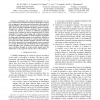Free Online Productivity Tools
i2Speak
i2Symbol
i2OCR
iTex2Img
iWeb2Print
iWeb2Shot
i2Type
iPdf2Split
iPdf2Merge
i2Bopomofo
i2Arabic
i2Style
i2Image
i2PDF
iLatex2Rtf
Sci2ools
114
Voted
ICRA
2008
IEEE
2008
IEEE
Towards robust place recognition for robot localization
— Localization and context interpretation are two key competences for mobile robot systems. Visual place recognition, as opposed to purely geometrical models, holds promise of higher flexibility and association of semantics to the model. Ideally, a place recognition algorithm should be robust to dynamic changes and it should perform consistently when recognizing a room (for instance a corridor) in different geographical locations. Also, it should be able to categorize places, a crucial capability for transfer of knowledge and continuous learning. In order to test the suitability of visual recognition algorithms for these tasks, this paper presents a new database, acquired in three different labs across Europe. It contains image sequences of several rooms under dynamic changes, acquired at the same time with a perspective and omnidirectional camera, mounted on a socket. We assess this new database with an appearancebased algorithm that combines local features with support vector mach...
Related Content
| Added | 30 May 2010 |
| Updated | 30 May 2010 |
| Type | Conference |
| Year | 2008 |
| Where | ICRA |
| Authors | Muhammad Muneeb Ullah, Andrzej Pronobis, Barbara Caputo, Jie Luo, Patric Jensfelt, Henrik I. Christensen |
Comments (0)

